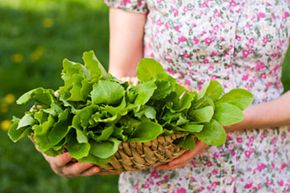So, you want to grow a vegetable garden, but trees and buildings shade your yard for much of the day. Sure, you could take a chainsaw and a wrecking ball to everything that casts a shadow (like a crazy maniac). But there's a much less drastic solution: Plant veggies that grow well in low-light conditions.
Vegetables, like all plants, convert sunlight, water and carbon dioxide into sugar and oxygen in a process known as photosynthesis. They use the sugar to fuel basic functions like growth and reproduction, then store what's leftover in the delicious stems, roots and fruits that we harvest for salads and stir fry. Generally speaking, the more sunlight a plant gets, the more energy it's able to generate and the more yummy veggies it will produce. For this reason, plants located in partial shade may not be as luxuriant and robust as those that hang out in full sunlight, but many will still yield great-tasting edibles.
Advertisement
Just like you wouldn't power a flashlight that takes four batteries with just one, you shouldn't plant vegetables that require a lot of energy in a shady garden. Leafy greens, which require as little as two hours of full sunlight a day, are your best bet. These include lettuce, spinach, Swiss chard, arugula, endive, radicchio, kale, mustard, cabbage and bok choy. Herbs like cilantro, chives, mint and lemon balm will also grow in these shadowy conditions. With a little more sunlight -- around four hours daily -- you can also raise root vegetables like potatoes, beets, carrots and turnips. The worst vegetables for a shady garden are those that fruit from a flowering plant, like tomatoes, cucumbers, peppers, squash and eggplants. Without six or more hours of full sunlight per day, these energy-guzzlers will produce little more than frustration.

